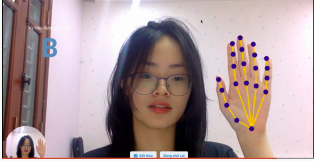Vietnamese Sign Language Translation Research
Currently, around 1
million to 2.5 million Vietnamese belong to the Deaf and Hard of Hearing group; however, only an alarming 10
Vietnamese reach the
acceptable proficiency for interpreting Vietnamese Sign Language (Kiều Tuyết & Nguyễn Yên, 2020). As a
matter of consequence,
their minority leads to tremendous problems including the feeling of isolation and lack of self-confidence,
as well as struggles in other aspects of daily life (Xuân Mai, 2020). Concerning healthcare, although the
Vietnamese Ministry of Health has stated the A2.5 principles, which assure that the Deaf and Hard of Hearing
is supported by
ever-present translator agents while being treated, the policies are poorly executed in real life. Hospitals
lack resources or even neglect these special principles concerning the needs of Deaf and Hard of Hearing.
Current Sign Language training/learning systems have limitations that can be seen as barriers for Vietnamese Sign Language learners such as little time flexibility as the course gets harder, and inconsistency of materials (Hồng Quý, 2007). Due to our survey with information from 100 learners who are Deaf/ Hard of Hearing people, their families, doctors, and nurses, we also found that other problems include limited practice ability without an expert tutor, and course prices.
VieSign has been able to solve some of these dominant problems like course prices and little time flexibility with our free MOOC curriculum; however, lack of in-person practice is still untackled. Therefore, we have been looking into ways to create a Sign Language Recognition and Translation Model that can be integrated into our free MOOC platform. The model will be able to solve both aforementioned problems by providing students a way to practice sign language just through live cameras right on the platform. Our previous attempts include creating the alphabetical sign language detection using TensorFlow and Handpose model; however, we have been looking into newer computer visual detection and natural language processing technologies that may achieve greater performance in recognizing and translating continuous sign language.
Current Sign Language training/learning systems have limitations that can be seen as barriers for Vietnamese Sign Language learners such as little time flexibility as the course gets harder, and inconsistency of materials (Hồng Quý, 2007). Due to our survey with information from 100 learners who are Deaf/ Hard of Hearing people, their families, doctors, and nurses, we also found that other problems include limited practice ability without an expert tutor, and course prices.
VieSign has been able to solve some of these dominant problems like course prices and little time flexibility with our free MOOC curriculum; however, lack of in-person practice is still untackled. Therefore, we have been looking into ways to create a Sign Language Recognition and Translation Model that can be integrated into our free MOOC platform. The model will be able to solve both aforementioned problems by providing students a way to practice sign language just through live cameras right on the platform. Our previous attempts include creating the alphabetical sign language detection using TensorFlow and Handpose model; however, we have been looking into newer computer visual detection and natural language processing technologies that may achieve greater performance in recognizing and translating continuous sign language.
For collaboration, please contact us for more information. We are always happy to hear from you!
1. Kiều Tuyết & Nguyễn Yên (2020, Dec. 7). Thiếu phiên dịch viên, bệnh nhân đặc biệt thiệt thòi về cơ hội chăm sóc y tế. VOV Giao thông. https://vovgiaothong.vn/.
2. Xuân Mai (2020, Nov. 15). Bệnh viên thiếu người phiên dịch cho bệnh nhân khiếm thính. Tuổi Trẻ VN. https://tuoitre.vn/.
3. Hồng Quý (2007, Dec. 11). Học Ngôn ngữ ký hiệu dễ hay khó?. Đại học Quốc gia Hà Nội. https://www.vnu.edu.vn/
